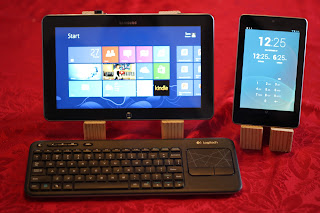
Day 27 – IE 10 The best of both worlds on a Windows 8 Tablet
A Windows 8 Tablet for Teaching and Learning - Day 27
Monday, December 31, 2012
This may come as a surprise to some, but the new Internet Explorer 10 is the best browser for use on a Windows 8 tablet. I say a surprise because Internet Explorer has been losing marketshare to the Google Chrome browser for the past couple of years but that trend may now be reversing with the introduction of IE 10 on Windows 8. One of the strengths of Windows has always been end user choice of using best of breed applications that best fit the job. In recent years Internet Explorer has become maligned as the browser that is old and behind the times but the new IE 10 has been modernized with a redesigned interface for Windows 8.
Like many things on this Windows 8 tablet Microsoft has taken the hybrid approach of introducing new elements while maintaining backward compatibility.
Internet Explorer 10 in Windows 8 is no exception, IE 10 also has this dual personality.
First, if you access IE 10 from the Start Screen you will be using the metro-style version of IE 10. The metro-style version provides a new interface for the browser that is “chromeless”. Chrome, (not the Google Browser), in this case means getting rid of all the menu and address bars that you normally see at the top of your browser. This presents a very clean look that gets the ugly interface controls out of the way. If you want to see the controls again simply swipe down from the top (or swipe up from the bottom) of the tablet and you will see the address bar at the bottom of the screen. At the top of the screen you will see a thumbnail of each browser window you have open. There is a + sign in the upper right hand corner if you want to open another “tab”. Tabs appear as thumbnails in the metro-style version of IE 10.
There is also the traditional “Desktop” version of IE 10 that you can get to by going to the Desktop of the Windows 8 tablet and tapping the Internet Explorer icon located in the lower left hand corner of the Desktop.
Remember, the Desktop on Windows 8 does not have the Start button, it uses the Start Screen in its place. This is one of those “who moved my cheese” moments that some have a hard time adjusting to and lament its removal. Get over it, the Start button is gone in Windows 8 and once you realize that and get on with your life you will find the Start screen much more efficient and customizable.
Remember, the Desktop on Windows 8 does not have the Start button, it uses the Start Screen in its place. This is one of those “who moved my cheese” moments that some have a hard time adjusting to and lament its removal. Get over it, the Start button is gone in Windows 8 and once you realize that and get on with your life you will find the Start screen much more efficient and customizable.
In the past I have split my browser time about 50/50 between Internet Explorer and Chrome. Since using the Samsung Ativ Smart PC 500T tablet I have changed that percentage to about 90/10 using Internet Explorer about 90% of the time. For the 10% of the time I use Chrome it is for some of the Chrome apps that I use. The great thing is I have a choice and I am now finding IE 10 to be the better solution for me on a Windows 8 tablet.
The biggest reason I favor IE 10 ninety percent of the time is that I like the new clean “chromeless” (no pun intended) look. IE 10 also supports pinch and zoom when using either the metro-style version or Desktop version of IE 10. Google Chrome on the Windows 8 Desktop does NOT currently support pinch and zoom.
The second biggest reason that I like to use IE 10 as my primary browser is that I still run into a lot of websites that use Adobe Flash. The metro-style version of IE 10 does not support Flash but the “Desktop” version does.
Tip: There is a nice shortcut when you run into a website that needs Adobe Flash. You can swipe up from the bottom of the screen, click on the “Wrench” icon and select “View on Desktop”. This opens the website you are currently on in the metro-style version of IE 10 into the “Desktop” version of IE 10 that DOES support Adobe Flash. I use this little shortcut a lot when I need to view Flash content. Many educational videos and screencasts are still delivered via Flash.
Confusing? Not really, don’t make it any harder than it is. You have two styles of the IE 10 browser for use in Windows 8. The metro-style version is available from the Start Screen and has a clean “chromeless” look. The “Desktop” version of IE 10 is available from…. wait for it, the Desktop. Use whatever style of IE 10 you like, again it is great to have a choice. Instead of ignoring the millions of websites that STILL use Adobe Flash you have an alternative to view the content if you need to. This is another case of the hybrid approach Microsoft is taking to maintain backward compatibility until the new technologies meant to replace Flash catch up with new software capabilities like HTML 5.
The best of both worlds, old and new.
Because the Samsung Ativ 500T tablet uses the x86 processor I can also install and use Firefox and/or Chrome browsers in addition to IE 10 if I would like.
Choice is good, so is this tablet.
Keep on Learning,
Dr. Grissom
Dr. Grissom






